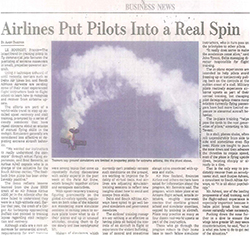From the APS Corporate Administrator: “The following summary was written by Malina ‘Molly’ Dallmann, at APS Texas, in reference to the above-cited Wall Street Journal Article (WSJ) on airline upset training. The original article is available to WSJ members and, in approximately 4 weeks, it will be released to the general public. We’ve provided a link at the end of the article for those with Wall Street Journal memberships.”
Original Article (20 June 2015): “Airlines Put Pilots in a Real Spin in New Training Initiative” – Andy Pasztor
Article Summary and Open Discussion by APS
The IS NOT a reproduction of the original article.

At the recent Paris Air Show, there were discussions over requirements for stall training, and although stalls are a rare occurrence for commercial aircraft, two major events in an Airbus A330 (Air France flight 447) and a Colgan Air turboprop (flight 3407) brought to light the need for enhanced training. Regulators are mandating additional simulator sessions to mitigate the problems due to a lack of training in the area of upset recovery. Despite advances in simulator technology, South African Airways and Delta Air Lines Inc. have opted to go beyond simulator training and the new government mandates. The training managers for these major carriers maintain that nothing is as effective as having their instructors behind the controls of an aircraft to experience the violent motion that can be associated with upsets and stalls.
He goes on to say that the flight school experience helps the pilot break from what comes naturally and though pushing the nose further into a dive may seem counter-intuitive “it is what you have to do to get out of the situation.” Private pilots spend time practicing aerodynamic stalls before they get their license. Regulators in Europe have now mandated additional stall-recovery practice in flight for pilots training for approval of a commercial license. The question has been raised of at what stage during their training pilots should be exposed to stall-recovery maneuvers. Patrick Ky, the European Union’s top air-safety official, said that the latest rules require that “all pilots will have to be trained in a real aircraft” in these enhanced recovery procedures prior to being cleared to fly passengers. Insurers are even agreeing to pay for some of the tuition of this training after hearing of the safety benefits. As mentioned previously, other airlines are looking into this training; an extremely important step forward for the safety of the crews and passengers of these carriers.
Article Summary and Open Discussion by Malina ‘Molly’ Dallmann, APS Texas
LINK: Original Article (20 June 2015): “Airlines Put Pilots in a Real Spin in New Training Initiative” – Andy Pasztor
Comments: